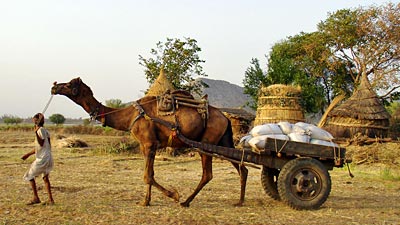| ||
| ||
| |
 The states of Goa, Gujarat, Rajasthan and Maharashtra comprise the western region of India. The villages in these states are famous for their richness in tradition, culture, agriculture and other aspects. The people mainly depend on agriculture for earning their livelihoods. However, they are engaged in other traditional and non-traditional occupations as well. The villagers in west India are fond of music and dance and they perform various forms of folk dance and music during the festivals.
The states of Goa, Gujarat, Rajasthan and Maharashtra comprise the western region of India. The villages in these states are famous for their richness in tradition, culture, agriculture and other aspects. The people mainly depend on agriculture for earning their livelihoods. However, they are engaged in other traditional and non-traditional occupations as well. The villagers in west India are fond of music and dance and they perform various forms of folk dance and music during the festivals.Food is one of the most important aspects of village life in west India. The women like to experiment with their cuisine and try to cook new types of food items. They use a variety of spice to make both vegetarian and non-vegetarian types of food items. The most famous food items found in the villages of west India include Bhel Puris of Maharashtra, Dhoklas of Gujarat, Bati Choorma of Rajasthan and Vindaloo (Pork) of Goa. Apart from these, the other famous food items include Shrikhand, Gujarati Kadhi, Batata Vada (Potato Dumplings), Besan ka Cheela, Khandvi, Goan Fish Curry (Hot and sour), Sorpotel, Dahi Keema Samosa, Papad ki Sabzi, Makki Doodhi Ra Moothiya, Ghevar, Mawa Misri, Macchhili Jaisamandi, Nawabi Biryani, etc. The West Indian people also like to eat a variety of sea food including the fish items.
The traditional costumes worn by the people in the villages of west India are unique in their colour, design and wearing style. The men in the villages of Rajasthan wear a turban and angarakha - a traditional dress worn above the waist. Sometimes, they wear dhotis or pyjamas, along with the angarakha. The men mostly wear white and silk dhotis with zari borders. On the other hand, the women in the villages of Rajasthan usually wear long skirts known as ghagra and a choli (blouse). They also sometimes use a dupatta with the ghagra-choli. In Maharashtra, men generally wear dhoti and shirt, along with a head dress named `pheta`. The women in the villages of Maharashtra wear Sarees with a short sleeved choli (blouse). The men wear in the villages of Gujarat is quite different from those of other parts of west India. The Gujarati men wear a common dress named `chorno` for the lower part of the body. Another dress named `kediyu` or angarakhu is worn for the upper part of the body. They also wear a `phento` or turban. The Gujarati women in villages usually wear a colourful petticoat named `chaniyo`, which is often embroidered with abhala, or round glass pieces. They wear a choli for the upper part of the body. They also use the `odhni`, along with chaniyo and choli.
Agriculture is the main occupation for most of the villagers in west India and hence, is the backbone of village life in west India. The villagers are engaged in cultivations of various types of crops throughout the year and the villages in west India are some of the highest producers of food grains in India. The major crops cultivated in the villages of west India include groundnut, cotton, tobacco, isabgul, cumin, sugarcane, jawar, bajra, rice, wheat, pulses, tur, gram, banana, etc. Apart from these, the villagers in west India also produce honey, wax and bamboo; the medicinal herbs and fruits like Jamun and guava; teak, Khair, sadad, hadariyo, manual bamboos, etc. Apart from agriculture, the rural people in west India are also engaged in dairy farming, textiles, chemical and pharmaceutical industries, petroleum, cement production, etc.
One of the most important parts of village life in west India is education. The people in the villages are well aware about the advantages and positive aspects of education and hence, they send their children to the schools. The children receive primary education from the government primary schools established in the villages. There are many secondary schools established in many villages in west India, where students can receive secondary education. The rural literacy rate in west India is quite impressive and efforts are being taken to further improve this scenario.
People in the villages of west India celebrate a variety of fairs and festivals throughout the year. The fairs and festivals have always been an integral part of village life in west India. All the major festivals like Diwali, Holi, Dussehra, etc. are celebrated with much joy and cheerfulness in the villages of west India. Most of the traditional festivals in west India date back to the early Raja and Maharaja eras and people celebrate festivals of every religion like Hindu, Muslim, Jain, Buddhist, etc. together. Some of the popular festivals celebrated in the villages of west India include the Ganesh Chaturthi, Christmas, Gangaur festival, the Mewar festival, Urs, Baneshwar Fair, Teej, Kite festival, Dang Darbar, Janmashtami, Navaratri, Diwali, Gudhi Padava (the Marathi New Year), Nagpanchami, the Parsi New Year of Pateti, the Narali Purnima, Raksha Bandhan day, etc. The other major festivals are Pola (when the farmer decorates his cattle, worships it and feeds them with goodies), the Vasco Saptah, (a week long festivity dedicated to Lord Damaodar), Chovoth or the Ganesh Puja, Touxeachem Fest (in Konkani) literally translates as the Cucumber Feast, etc.
The village life in west India is a culturally rich. The people like to eat different types of food items, wear a variety of costumes and also celebrate various colourful festivals. They also perform various forms of folk music and dance during the festivals. Their extraordinary style of celebrating festivals attracts many tourists from all over the country every year.
No comments:
Post a Comment